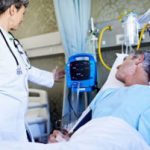Blog
Putting patient safety first: 4 ways technology can drive positive patient outcomes
In 2024, an American Hospital Association study found that hospitals cared for more people compared to pre-pandemic years. The data reveals a 3% increase in patient acuity, or the severity or complexity of medical conditions, further emphasizing patient safety within healthcare spaces.
In their latest report, the ECRI (Emergency Care Research Institute) explored this topic by outlining their top patient safety concerns for 2025. The rankings are based on surveys and safety reports, reflecting on the real issues affecting patient outcomes in hospitals across the country.
Clinical communication solutions can help healthcare organizations develop more effective strategies for delivering better care. Here are four examples of their impact on patient safety.
1. Diagnostic errors
The ECRI explains that errors can originate from several sources, including communication breakdowns throughout a diagnostic procedure, which can result in failures to order, collect, and process radiology tests.
Diagnostic errors directly impact patient outcomes in healthcare. According to Johns Hopkins Medicine, an estimated 12 million Americans are affected by diagnostic errors and may account for 40,000-80,000 deaths in American hospitals annually.
Critical test results notification (CTRN) solutions are a key component of any effective treatment strategy; they ensure that once abnormal results are identified, this information is delivered to the right clinicians at the right time. When time is of the essence, your care teams are equipped with the knowledge to achieve better patient outcomes.
2. Poor communication during discharge process
Did you know that 67% of communication failures are related to handoffs? Ineffective care transitions can result in more adverse events and increased healthcare costs. To prevent these issues, it’s essential that every clinician is well-informed and aligned with coordinating care.
Care team sizes can vary greatly from hospital to hospital, directly impacting how effectively care is communicated and delivered. For example, in a single integrated health system that serves rural and urban areas in 59 different Midwestern communities, their care teams typically consisted of four clinicians, with larger teams consisting of 10 people.
With a secure messaging solution that protects patient information, your hospital can streamline the flow of communication—leading to better care team collaboration and positive patient outcomes.
3. Mistakes and delays caused by cybersecurity breaches
Cybersecurity has emerged as one of the most pressing challenges in today’s healthcare environment, making it a top priority for hospital administrators.
As part of a survey with Proofpoint, 89% of healthcare organizations reported experiencing at least one cyberattack in the past year. Cyberattacks take on many forms, from data loss to blocking network-connected devices, causing widespread disruptions for care teams and ultimately influencing patient outcomes.
Secure messaging solutions are designed with end-to-end encryption, which conceals messages with unique keys that are later decoded when received by other users. If your hospital is dealing with a cyberattack, this information cannot be read by malicious actors.
4. Unique healthcare challenges for veteran patients
There are more than 18 million living veterans in the United States who face unique health issues due to their military service.
When looking at the Wounded Warrior Project Survey, almost 80% of participants described themselves as dealing with sleep problems along with “a physical or mental injury, illness, or wound.” 76% cited the same when dealing with post-traumatic stress disorder (PTSD).
If your clinicians are not aware of this information, veterans are at risk for missed diagnoses and inadequate care, which can lead to negative patient outcomes. A unified communication platform ensures that this information is delivered to every member of your care teams so they can be empowered to create the best treatment plan possible.
Effective technology and enhanced care team collaboration are essential for improving patient outcomes. These four examples perfectly illustrate how automatic and accurate processes can save valuable time for your clinicians, allowing them to focus on delivering exceptional care.






